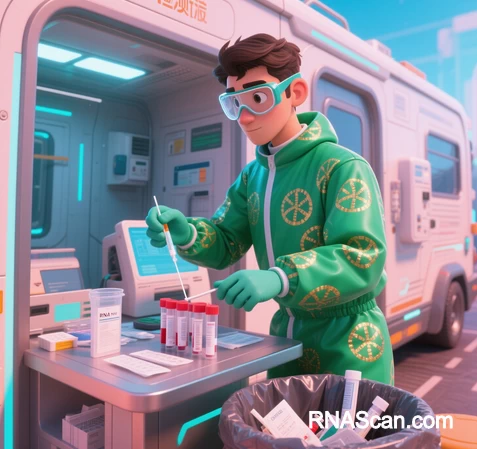 Introduction
Introduction
RNAScan technology—a suite of methods for targeted RNA detection, structural profiling, and functional annotation—relies on ultra-sensitive workflows to identify biomarkers, fusion genes, and RNA modifications. While instrumentation and bioinformatics are vital, RNase-free pipette tips emerge as the most critical consumable, acting as the frontline defense against RNA degradation. Contamination by ribonucleases (RNases)—ubiquitous enzymes that rapidly degrade RNA—compromises assay sensitivity, reproducibility, and diagnostic accuracy. This article delineates why RNase-free tips are indispensable, their technical specifications, and optimization strategies for RNAScan workflows.
1. The Vulnerability of RNA and RNase Contamination Risks
A. RNase Stability and Pervasiveness
RNases are exceptionally stable enzymes resistant to heat, denaturants, and sterilization. They persist on skin, lab surfaces, and non-certified consumables . A single RNase molecule can degrade micrograms of RNA within minutes, causing:
- False negatives in fusion gene detection (e.g., KMT2A-PTD in leukemia).
- Reduced sensitivity for low-abundance targets (e.g., viral RNA or circular RNAs).
B. Critical RNAScan Failure Points
During RNA extraction, library prep, and hybridization, pipette tips contact RNA at high-risk stages:
- Sample Transfer: Non-RNase-free tips introduce contaminants during RNA isolation .
- PCR Setup: Contaminated tips degrade templates during amplification .
- Hybridization: RNases disrupt probe-binding in RNAscope assays .
Suggested Figure: RNase Contamination Pathway: RNase on tip surface → RNA degradation during pipetting → Reduced signal intensity in RNAScan output.
2. Technical Specifications for Optimal RNase-Free Tips
A. Material and Manufacturing
- Polymer Purity: Medical-grade polypropylene without additives (e.g., dyes or plasticizers) that leach RNases .
- Certification: Third-party validation via fluorometric RNase assays (e.g., Ribonuclease Alert™ Kit) confirming undetectable RNase activity .
- Surface Treatment: Hydrophobic coatings (e.g., Axygen’s Maxymum Recovery®) to minimize sample adhesion .
B. Design Innovations
- Filter Barriers: Porous polyethylene filters (0.2 µm) block aerosols and cross-contamination .
- Low Binding Tips: Ultra-smooth interiors reduce RNA loss during liquid handling .
3. Comparative Analysis: Leading RNase-Free Tip Suppliers
| Supplier | Key Product | Unique Feature | RNAScan Application |
|---|---|---|---|
| Axygen | Maxymum Recovery® Tips | Hydrophobic polymer; >99.9% sample recovery | Fusion detection in low-input samples |
| Thermo Fisher | ART™ Barrier Tips | Aerosol-resistant filter; DNase/RNase-free certification | Viral RNA sequencing |
| Capp | ExpellPlus™ Tips | Ultra-smooth interior; 99.9% bacterial filtration | Single-cell RNAScan |
4. Integration with RNAScan Workflows
A. RNA Extraction and QC
- Use RNase-free tips with High Pure FFPE RNA Kits to preserve degraded clinical samples (RIN >8.0) .
- Pair with Qubit® RNA HS Assay for accurate quantification .
B. Hybridization and Detection
- RNAscope Assays: Tips must comply with HybEZ™ II protocols to prevent probe degradation .
- Liquid Biopsies: Low-binding tips minimize loss of circulating tumor RNA .
Suggested Figure: Optimized Pipetting Workflow: RNase-free tip selection → Filter barrier protection → Minimal sample retention in tip.
5. Consequences of Non-Compliant Tips
A. Case Study: Fusion Gene False Negatives
In leukemia diagnostics, non-RNase-free tips degraded 70% of KMT2A-PTD fusion templates, leading to:
- Reduced sensitivity (0.1% → 1% allele frequency detection limit).
- Misclassification of minimal residual disease (MRD) status .
B. Economic and Reproducibility Costs
- Rerun Costs: 500–1,000 per failed RNAScan panel.
- Publication Retractions: 12% of molecular biology retractions link to RNase contamination .
6. Future Innovations: Smart Tips and Automation
- Sensor-Embedded Tips: RFID chips alert users to RNase contamination in real-time.
- Automated Tip Handling: Integration with Hamilton NGS STAR systems eliminates human error.
- Biodegradable Polymers: Sustainable RNase-free tips from plant-based plastics.
Conclusion
RNase-free pipette tips are the unsung heroes of RNAScan technology. Their role in preventing RNA degradation is non-negotiable for:
- Clinical Diagnostics: Detecting fusions at 0.1% allele frequency.
- Research Reproducibility: Ensuring consistent RNA integrity from sample to sequencer.
- Therapeutic Development: Validating RNA targets for CRISPR-based therapies.
Investing in certified tips (e.g., Axygen, Thermo Fisher) is not a luxury—it is the bedrock of reliable RNA science.
Data Source: Publicly available references.
Contact: chuanchuan810@gmail.com
